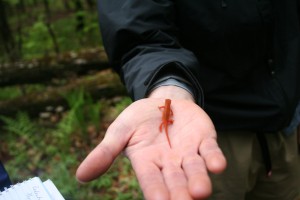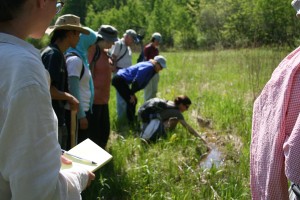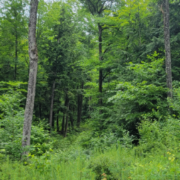Naturalists: Nature’s Interpreters
October 9, 2013
Maggie Stoudnour, UVLT Environmental Education Consultant
Being a naturalist is more than just knowing about the natural world. It’s also about sharing that knowledge with others. Often, I think this pairing comes, well, naturally! In order to know a lot about something, it helps to be interested in it. And if you are interested in something enough to learn about it, it’s a quick leap to being passionate about it. And when someone is passionate about something, he or she can’t help but share it with other people. I’ve noticed, however, that many people have trouble putting this last part into action. There is something (or multiple “somethingsâ€) that give us pause when it comes to doing the show-and-tell that comes along with being a naturalist. While an interest in nature and a desire to share it with others comes easily, feeling confident and comfortable enough to actually do it takes some time and even a little skill.
Luckily, nature does a lot of the work for us. Our role as naturalists is simply to interpret the things we see every day on our walks in the woods and even in our own backyards so that they becoming meaningful. A “plant†that we have always walked right past and barely noticed becomes an individual with a name and a story. What were once some scratches on a tree take on new life as evidence of bear. A plain old rock becomes an entry point into the last ice age. The background noise of birdsong turns into a symphony of voices, each belonging to its own small feathery singer.
Beginning naturalists often find it difficult to think about how they might begin to tackle their role as nature’s interpreters. They worry that maybe they don’t know enough. They worry someone in the group might know more than they do about their topics. They worry about being boring and losing the interest of their participants. They worry about saying something wrong or inaccurate. They worry they won’t be able to lead the group effectively.
 As it happens, nature interpretation isn’t new, and there are some tried and true techniques for sharing nature. All it takes is a willingness to learn and a little practice. The first thing to realize is that interpretation is just a style of presentation, and the basic rules of presenting apply: smile, face your audience, speak loudly enough for everyone to hear, be enthusiastic about your topic (and choose a topic that you don’t need to fake enthusiasm for), make eye contact, etc. The uniquely wonderful fact that the presentation is happening outdoors, on the move, and most likely in a beautiful place comes with some additional challenges. Keeping people’s interest when there are so many distractions requires more than just standing and talking. Nature interpretation begs to be interactive, experiential and hands-on. When people are outside, they want to touch, smell and taste. They don’t just want to look and listen, they want to explore. It behooves a naturalist to find ways to indulge these impulses. When people are outside, they want to move. Most often, the audience a naturalist interprets for is mixed, and it can take some creativity to meet the needs and expectations of children who have short attention spans and need to run and jump, younger adults who feel inspired to hike quickly between stops and senior citizens who need to take it slow. There are proven and relatively simple solutions to each of these challenges, which we will be delving into on Saturday’s workshop. Here’s a teaser, in no particular order:
As it happens, nature interpretation isn’t new, and there are some tried and true techniques for sharing nature. All it takes is a willingness to learn and a little practice. The first thing to realize is that interpretation is just a style of presentation, and the basic rules of presenting apply: smile, face your audience, speak loudly enough for everyone to hear, be enthusiastic about your topic (and choose a topic that you don’t need to fake enthusiasm for), make eye contact, etc. The uniquely wonderful fact that the presentation is happening outdoors, on the move, and most likely in a beautiful place comes with some additional challenges. Keeping people’s interest when there are so many distractions requires more than just standing and talking. Nature interpretation begs to be interactive, experiential and hands-on. When people are outside, they want to touch, smell and taste. They don’t just want to look and listen, they want to explore. It behooves a naturalist to find ways to indulge these impulses. When people are outside, they want to move. Most often, the audience a naturalist interprets for is mixed, and it can take some creativity to meet the needs and expectations of children who have short attention spans and need to run and jump, younger adults who feel inspired to hike quickly between stops and senior citizens who need to take it slow. There are proven and relatively simple solutions to each of these challenges, which we will be delving into on Saturday’s workshop. Here’s a teaser, in no particular order:
Maggie’s Top Ten Interpretive Tips
1. Â Develop a clear theme and build your stops around that theme
2. Â Alternate active time and listening time
3. Â Always stay in the lead and set the pace for the slowest person in the group
4. Â Look for and stop for teachable moments
5. Â Bring a few simple tools to encourage hands-on involvement
6.  Make use of questioning and other “interactive†styles of presenting
7. Â Channel your inner cartoon character
8.  Don’t try to memorize your talk
9. Â Plan no more than five stops and talk for no more than ten minutes at a time
10. Â Relax and have fun: your audience is on your side!



